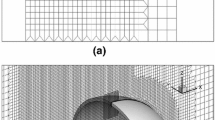Abstract
Systematic data on the determination of the aerodynamic characteristics of axisymmetric bodies with a break in the generating line (Fig. 1a, b) in supersonic flow at zero angle of attack are presented in [1, 2, and others]. A characteristic feature of the flow past such bodies is the appearance of an extensive separation zone dec in the region of the break in the generator when the break angle exceeds some minimum value δ∘≥δmin, which for a turbulent boundary layer depends basically on the Mach number M at the body surface ahead of the separation zone. In this case, compression waves which change into the oblique compression shocks dc′ and cc′, emanate both from the beginning of the separation zone (point c) and from the end of it (point d). These shocks, intersecting at the point c′, form the triple shock configuration ac′d and ac′c for which we introduce the notationac′[c, d]. The maximum value (δmax) of the generator break angle is limited by the possibility of the existence of an attached compression shock, dc′. According to these data a change in the generator break angle for the range δmin≤δ∘≤δmax of the angle does not disrupt the nature of the flow in the separation zone, but only alters the size of this zone.
We shall examine the flow past cones with values of the generator break angles (δ∘≥δmax) for which the attached shock dc′ cannot exist.
Similar content being viewed by others
References
D. M. Kuehn, “Turbulent boundary layer separation induced by flares on cylinders at zero angle of attack,” NASA Techn. Rept., no. R-117, 1961.
D. M. Kuehn, “Laminar boundary layer separation induced by flares on cylinders at zero angle of attack,” NASA, Techn. Rept., 1962.
Yu. A. Dem'yanov and V. N. Shmanenkov, “Study of reverse flows in the separation region of a turbulent boundary layer,” PMM, vol. 24, no. 2, 1960.
V. Ya. Neiland and G. I. Taganov, “The nature of flows in a separation zone,” Inzh. zh., vol. 2, no. 3, 1962.
G. E. Gadd, W. F. Cope, and I. L. Attridge, “Heat-transfer and skin-friction measurements at a Mach member of 2.44 for a turbulent boundary layer on a flat surface and in regions of separated flow,” Aero. Res. Counc. Lond. Rept. Mem., no. 3148, 1960.
S. M. Bogdanoff and C. E. Kepler, “Separation of a supersonic turbulent boundary layer,” J. Aeronaut. Sci., vol. 22, no. 6, 1955.
D. R. Chapman, D. M. Kuehn. and H. Larson, “Investigation of separated flows in supersonic and subsonic streams with emphasis on the effect of transition,” NASA Rept., no. 1356, 1958.
H. Korst, R. Page, and M. Childs, “A theory for base pressures in transonic and supersonic flow,” J. Appl. Mech., vol. 23, no. 4, 1956.
L. Crocco and L. Lees, “A mixing theory for the interaction between dissipative flows and nearly isentropic streams,” J. Aeronaut. Sci., vol. 19, no. 10, 1952.
V. Ya. Neiland and G. I. Taganov, “The configuration of forward separation zones for symmetric supersonic gas flow past bodies,” Inzh. zh., vol. 3, no. 2, 1963.
W. A. Mair, “Experiments on separation of boundary layers on probes in front of blunt-nosed bodies in a supersonic air stream,” Phil. Mag., vol. 43, no. 342, 1952.
C. J. Wood, “Hypersonic flow over spiked cones,” J. Fluid Mech., vol. 12, pt. 4, 1962.
Author information
Authors and Affiliations
Rights and permissions
About this article
Cite this article
Borisenko, V.M. Supersonic flow past axisymmetric flared cones. Fluid Dyn 4, 31–37 (1969). https://doi.org/10.1007/BF01025136
Issue Date:
DOI: https://doi.org/10.1007/BF01025136




